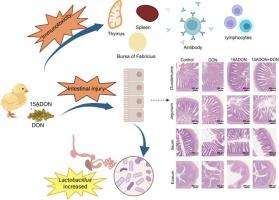Immunotoxicity and effects of gut microbiota in chicks exposed to low doses of deoxynivalenol and 15-acetyl-deoxynivalenol
IF 3.4
3区 医学
Q2 PHARMACOLOGY & PHARMACY
引用次数: 0
Abstract
Deoxynivalenol (DON) contamination in animal feed threatens livestock health due to chronic low-dose exposure and masked forms. 15-acetyl-deoxynivalenol (15ADON), a major masked form, exhibits stronger toxicity than DON in cell models, yet in vivo data, particularly in poultry, remain scarce. To address this gap, 1-day-old chickens were fed diets containing 3 mg/kg DON, 3 mg/kg 15ADON, or a combination of 1.5 mg/kg each. Immunotoxicity and cecal microbiota were evaluated through immune parameters and 16S rRNA sequencing. To examine cumulative effects, chickens were also exposed to low-dose DON at different developmental stages. Both DON and 15ADON induced evident immunotoxicity, including immune organ damage. Compared with controls, 15ADON reduced antibody titers against infectious bronchitis and Marek's disease viruses by 30 % and IgM levels by 50 % during early immune development. Co-exposure produced no synergistic effects, whereas prolonged low-dose DON exposure initially enhanced antibody production but later caused a 20–50 % decline relative to controls. Microbiota analysis revealed an increased abundance of Lactobacillus in DON and 15ADON treated groups, while overall microbial richness and diversity remained unchanged. These findings demonstrate that 15ADON exerts comparable immunotoxicity to DON, highlight the importance of exposure timing and duration, and reveal masked mycotoxins as underappreciated risks in poultry production. Our results provide valuable in vivo evidence to support the reassessment of regulatory limits and further investigation into masked mycotoxin toxicity.

低剂量脱氧雪腐镰刀菌醇和15-乙酰脱氧雪腐镰刀菌醇对雏鸡免疫毒性及肠道菌群的影响。
动物饲料中的脱氧雪腐镰刀菌醇(DON)污染由于长期低剂量暴露和掩蔽形式威胁牲畜健康。15-乙酰基脱氧雪腐镰刀菌醇(15ADON)是一种主要的掩膜形式,在细胞模型中表现出比DON更强的毒性,但在体内的数据,特别是在家禽中的数据仍然很少。为了弥补这一差距,在1日龄的鸡饲粮中分别添加3 mg/kg DON、3 mg/kg 15ADON或1.5 mg/kg的组合。通过免疫参数和16S rRNA测序评估免疫毒性和盲肠菌群。为了检验累积效应,鸡在不同发育阶段也暴露于低剂量DON。DON和15ADON均引起明显的免疫毒性,包括免疫器官损伤。与对照组相比,15ADON在早期免疫发育期间降低了针对传染性支气管炎和马雷克病病毒的抗体滴度30% %,IgM水平降低50% %。共暴露不产生协同效应,而长时间低剂量DON暴露最初增强了抗体产生,但随后导致相对于对照组下降20- 50% %。微生物群分析显示,DON和15ADON处理组乳酸杆菌的丰度增加,而总体微生物丰富度和多样性保持不变。这些发现表明,15ADON具有与DON相当的免疫毒性,强调了暴露时间和持续时间的重要性,并揭示了家禽生产中被掩盖的真菌毒素是未被重视的风险。我们的研究结果提供了有价值的体内证据,以支持重新评估监管限制和进一步调查隐匿真菌毒素的毒性。
本文章由计算机程序翻译,如有差异,请以英文原文为准。
求助全文
约1分钟内获得全文
求助全文
来源期刊
CiteScore
6.80
自引率
2.60%
发文量
309
审稿时长
32 days
期刊介绍:
Toxicology and Applied Pharmacology publishes original scientific research of relevance to animals or humans pertaining to the action of chemicals, drugs, or chemically-defined natural products.
Regular articles address mechanistic approaches to physiological, pharmacologic, biochemical, cellular, or molecular understanding of toxicologic/pathologic lesions and to methods used to describe these responses. Safety Science articles address outstanding state-of-the-art preclinical and human translational characterization of drug and chemical safety employing cutting-edge science. Highly significant Regulatory Safety Science articles will also be considered in this category. Papers concerned with alternatives to the use of experimental animals are encouraged.
Short articles report on high impact studies of broad interest to readers of TAAP that would benefit from rapid publication. These articles should contain no more than a combined total of four figures and tables. Authors should include in their cover letter the justification for consideration of their manuscript as a short article.

 求助内容:
求助内容: 应助结果提醒方式:
应助结果提醒方式:


